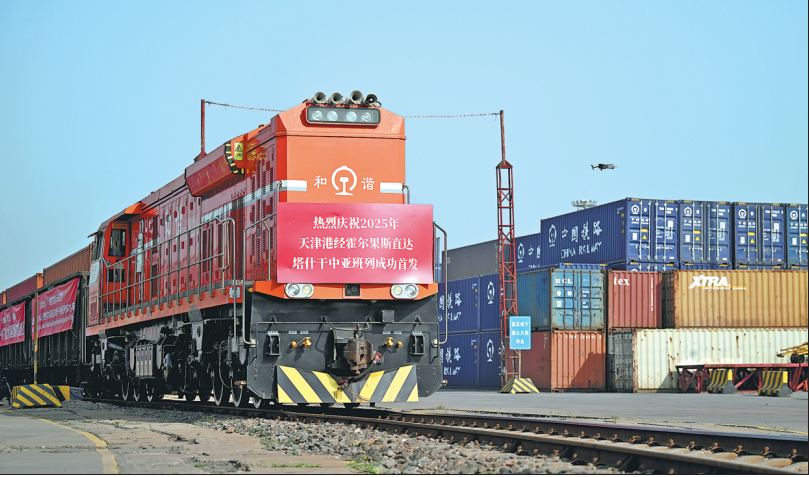China, SCO partners keen on sustainable growth
Common focus on win-win cooperation creates opportunities for participating economies, conditions for shared prosperity


China is working within the Shanghai Cooperation Organization mechanism to help accelerate cross-border trade, investment and local-currency settlements so as to expand infrastructure, digital and green-technology partnerships across Eurasia, officials and experts said.
The grouping, which brings together China, Russia and Central Asian states alongside other participants, spans a market of more than 3.5 billion people, and experts say Beijing's economic engagement now ranges from traditional energy and minerals to logistics, digital services and green industries.
Galina Kulikova, first vice-president of the Russia-China Friendship Association (RCFA), said China's approach inside the SCO stresses "equal partnership and mutual benefit", adding that Beijing is not only a financier, but also a catalyst for sustainable economic growth that respects each partner's sovereignty and development path.
China's commitments to opening its domestic market, facilitating trade and backing infrastructure and connectivity projects have created tangible growth opportunities for all members, she said, describing an agenda that also includes sharing development experience, fostering technology transfer in the digital economy and green tech, and supporting capacity building in less developed economies.
Kulikova, who received China's Friendship Medal in 2019, said Beijing consistently demonstrates its commitment to building a community with a shared future for humanity within the SCO, arguing that sustained emphasis on win-win economic cooperation is helping create the conditions for shared prosperity.
Sergey Suverov, chief investment strategist at Moscow-based Aricapital Asset Management, said the bloc's geographic scale and population underpin tremendous potential across transport infrastructure, mutual trade, cross-border investment and financial transactions, but this potential has not yet been fully realized.
Suverov said turning broadly positive political relations into deeper commercial integration requires strengthening collaboration mechanisms, including specialized financial, banking and investment structures; harmonizing economic legislation; jointly financing priority infrastructure; and forming joint ventures "from automobile manufacturing to information technology".
Li Xuenan, a professor of finance and director of the China Industrial Policy Research Center at the Cheung Kong Graduate School of Business (CKGSB), said the SCO's economic agenda in recent years has centered on transport and logistics, coordination of industrial and supply chains, digital trade and green cooperation in the energy sphere.
Bilateral trade between China and other SCO participants has repeatedly hit new highs and now constitutes a rising share of the economic output of both China and partner countries, Li said.
By creating what Li called a "pragmatic platform" for economic issues and establishing bilateral trade cooperation mechanisms under China's guidance, the SCO has promoted subnational alignment and mutual benefit.
"There remains substantial room for China-SCO bilateral trade," he said, and China is already a principal trading partner for countries including Kazakhstan, Uzbekistan and Pakistan.
Deeper cooperation in transport infrastructure, energy corridors and digital services trade is reinforcing the supportive role of commerce and investment in economic restructuring and growth across the region, Li said, underscoring that SCO multilateral cooperation possesses sustainability and a demonstrative effect that injects steady momentum into broader regional prosperity.
Trade between China and SCO member states, observer states and dialogue partners reached $890.3 billion in 2024, accounting for 14.4 percent of China's total goods trade, said Liu Huaqin, a researcher at the Chinese Academy of International Trade and Economic Cooperation, which is part of the Ministry of Commerce. Liu said the figure demonstrates both diversification in China's external commerce and the bloc's integration drive.
However, differences in regulatory frameworks and project financing maturity among member states continue to slow conversion of proposed infrastructure into real-time results, said Suverov.
Ministry data showed China's cumulative investment stock in SCO member, observer and dialogue partner economies exceeded $140 billion by end-2024. Chinese enterprises' cumulative newly signed overseas engineering contracts in those jurisdictions surpassed $1 trillion in value, with completed turnover of more than $680 billion.
In addition, according to data from the ministry, China has become the largest single source of investment for Kyrgyzstan, Uzbekistan and Tajikistan and the fifth-largest for Kazakhstan, as investment flows expand beyond traditional energy and mineral resource projects into agricultural processing, green energy, automobile manufacturing and logistics.
Gulnar Shaimergenova, director of the China Studies Center in Kazakhstan, said China plays a vital role in promoting regional security, cooperation and shared development through multilateral platforms such as the Belt and Road Initiative as well as the SCO.
She said China has organically integrated technological progress with traditional inheritance in advancing Chinese-style modernization, providing valuable experience in urban governance worthy of study by other SCO countries.
Moreover, financial cooperation is widening through local-currency swap arrangements and settlement initiatives, while regional banks deepen ties. Xinjiang Bank, a regional bank based in Northwest China's Xinjiang Uygur autonomous region, has established correspondent relationships with seven banks in Central Asian countries.
Chinese digital payment platforms WeChat Pay, Alipay and Ant Group-linked services have connected with Kazakh firms, and China UnionPay cards have been locally issued in Kazakhstan, Kyrgyzstan, Tajikistan and Uzbekistan.
Suverov views the expansion of local-currency settlements as a gradual hedge against external financial volatility and a facilitator of lower transaction costs. He said broader uptake will still depend on liquidity depth, pricing transparency and risk management tools in regional foreign exchange and money markets.
Suverov from Aricapital Asset Management added that improving the institutions of collaboration, including specialized investment vehicles and harmonized regulations, will help shift potential into executed projects, especially in cross-border logistics, rail corridors and manufacturing clusters.
Establishing joint ventures in priority industries could accelerate a regional division of labor that raises productivity and embeds supply-chain complementarity, provided that governance and financing frameworks are standardized, Suverov said.
Kulikova from the RCFA agreed, noting that China's promotion of joint infrastructure and connectivity aligns with partner states' development plans and can amplify regional value chains if combined with technology transfers and capacity-building programs.
She framed China's role as helping to create "conditions for shared prosperity", while Li from CKGSB emphasized what he described as the demonstrative, confidence-building effect of sustained project delivery under the SCO umbrella.
Li said the rising share of digital services trade reflects convergence between traditional goods flows and newer data-driven and platform-based commerce, a trend he expects to accelerate as members invest in logistics digitization and green energy integration.
Contact the writers at renqi@chinadaily.com.cn

































